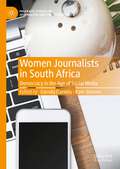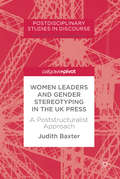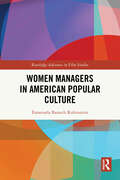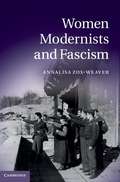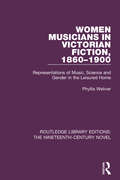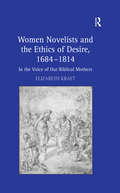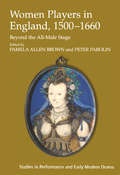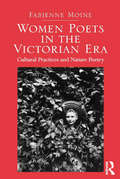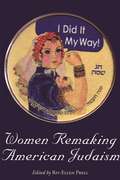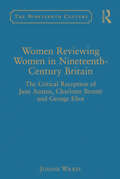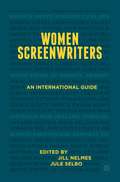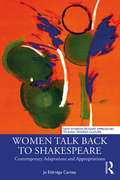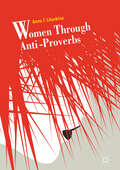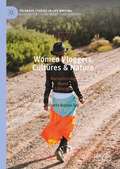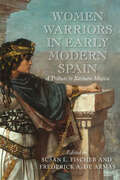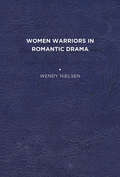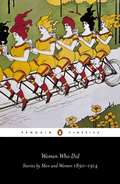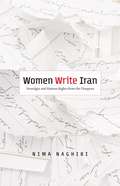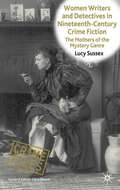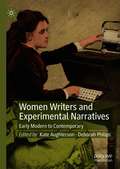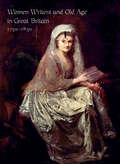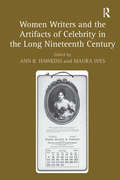- Table View
- List View
Women Journalists in South Africa: Democracy in the Age of Social Media (Palgrave Studies in Journalism and the Global South)
by Kate Skinner Glenda DanielsThis edited collection examines women journalists’ experiences and obstacles in South Africa’s (SA) democracy. They exercise power, and add a vital diversity, but they are routinely harassed in the online social media space of big tech companies such as Twitter and Facebook by populist and corrupt politicians and their supporters. Using SA as the case study, this book examines attempts to curb women journalists’ freedom combining theory and first-hand accounts. The target audience for the book includes scholars of political philosophy, gender, media, communications, NGOs, media freedom activists and journalists.
Women Leaders and Gender Stereotyping in the UK Press
by Judith BaxterThis book explores how the UK press constructs and represents women leaders drawn from three professional spheres: politics, business, and the mass media. Despite significant career progress made by women leaders in these professions, many British newspapers continue to portray these women in stereotyped and essentialist ways: the extent to which this occurs tending to correspond with the political affiliation and target readership of the newspaper. The author analyses news media articles through three fresh perspectives: first, Kanter's women leader stereotypes, second, a feminist agenda spectrum and third, a new 'reflexive' approach based on Feminist Poststructuralist Discourse Analysis. This book will appeal strongly to students and scholars of discourse analysis and media studies, and anyone with an interest in language, gender, leadership and feminism.
Women Managers in American Popular Culture (Routledge Advances in Film Studies)
by Emanuela Barasch RubinsteinThis book explores various portrayals of women managers in American culture from the late 1960s to the present.An analysis of iconic films and works of fiction and nonfiction reveals how the image of the woman manager has evolved over time, reflecting shifting societal attitudes. In early depictions, she is an extreme outlier: her life revolves entirely around work, she rejects family life, and she is often hypersexualized. In the 1980s, a decade marked by the rise of feminist ideals, she emerged as a realistic character, grappling with challenges that still impact women in management today. Yet this progression was short-lived. At the close of the 20th century and into the early 21st century, chauvinistic tropes resurfaced, once again casting her in a negative light. Contemporary portrayals of the female executive position her as part of a rapidly shifting social landscape. She is but one element in an emerging social construct.The study of the woman manager is pertinent to the humanities and the social sciences, bridging these disciplines. This interdisciplinary volume will be of interest to scholars and students in cultural studies, gender studies, American studies, and cinema studies, as well as those in economics, management, and business schools.
Women Modernists and Fascism
by Annalisa Zox-WeaverModernism both influenced and was fascinated by the rhetorical and aesthetic manifestations of fascism. In examining how four artists and writers represented fascist leaders, Annalisa Zox-Weaver aims to achieve a more complex understanding of the modernist political imagination. She examines how photographer Lee Miller, filmmaker Leni Riefenstahl, writer Gertrude Stein and journalist Janet Flanner interpret, dramatize and exploit Hitler, Göring and Pétain. Within their own artistic medium, each of these modernists explore confrontations between private and public identity, and historical narrative and the construction of myth. This study makes use of extensive archival material, such as letters, photographs, journals, unpublished manuscripts and ephemera and includes ten illustrations. This interdisciplinary perspective opens up wider discussions of the relationship between artists and dictators, modernism and fascism, and authority and representation.
Women Musicians in Victorian Fiction, 1860-1900: Representations of Music, Science and Gender in the Leisured Home (Routledge Library Editions: The Nineteenth-Century Novel #41)
by Phyllis WeliverOver the first half of the nineteenth century, writers like Austen and Brontë confined their critiques to satirical portrayals of women musicians. Later, however, a marked shift occurred with the introduction of musical female characters where were positively to be feared. First published in 2000, this book examines the reasons for this shift in representations of female musicians in Victorian fiction from 1860-1900. Focusing on changing gender roles, musical practices and the framing of both of these scientific discourses, the book explores how fictional notions of female musicians diverged from actual trends in music making. This book will be of interest to those studying nineteenth century literature and music.
Women Novelists Before Jane Austen
by Brian CormanBy the time Ian Watt published The Rise of the Novel. in 1957, it was clear that many women novelists before Jane Austen had been overlooked in critical studies of literature and that some of them had been completely forgotten by the reading public. In this book, Brian Corman explores the question of how and why this came about. Corman provides a systematic survey of the reputations of early women novelists as canons of the novel developed over a period of roughly two hundred years, and, in so doing, suggests reasons for their frequent exclusion.Women Novelists before Jane Austen challenges the view that exclusion from the canon was a simple function of gender and goes deeper to examine potential reasons why certain women writers were overlooked. In the process, it provides an overview of histories of the British novel from the beginning through to the mid-twentieth century, ending with the publication of Watt's famous text. Further, Corman offers a prolegomenon to the important recovery work of the late-twentieth century in which many revised accounts of the history of the novel appeared, essentially improving the scope covered by Watt. This study historicizes the place of early women novelists in the British canon in order to provide an informed context for current views.
Women Novelists and the Ethics of Desire, 1684–1814: In the Voice of Our Biblical Mothers
by Elizabeth KraftIn Women Novelists and the Ethics of Desire, 1684-1814, Elizabeth Kraft radically alters our conventional views of early women novelists by taking seriously their representations of female desire. To this end, she reads the fiction of Aphra Behn, Delarivier Manley, Eliza Haywood, Sarah Fielding, Charlotte Smith, Frances Burney, and Elizabeth Inchbald in light of ethical paradigms drawn from biblical texts about women and desire. Like their paradigmatic foremothers, these early women novelists create female characters who demonstrate subjectivity and responsibility for the other even as they grapple with the exigencies imposed on them by circumstance and convention. Kraft's study, informed by ethical theorists such as Emmanuel Levinas and Luce Irigaray, is remarkable in its juxtaposition of narratives from ancient and early modern times. These pairings enable Kraft to demonstrate not only the centrality of female desire in eighteenth-century culture and literature but its ethical importance as well.
Women Players in England, 1500–1660: Beyond the All-Male Stage (Studies in Performance and Early Modern Drama)
by Peter ParolinOffering evidence of women's extensive contributions to the theatrical landscape, this volume sharply challenges the assumption that the stage was 'all male' in early modern England. The editors and contributors argue that the pervasiveness of female performance affected cultural production, even on the professional London stages that used men and boys for women's parts. English spectators saw women players in professional and amateur contexts, in elite and popular settings, at home and abroad. Women acted in scripted and improvised roles, performed in local festive drama, and took part in dancing, singing, and masquing. English travelers saw professional actresses on the continent and Italian and French actresses visited England. Essays in this volume explore: the impact of women players outside London; the relationship between women's performance on the continent and in England; working women's participation in a performative culture of commerce; the importance of the visual record; the use of theatrical techniques by queens and aristocrats for political ends; and the role of female performance on the imitation of femininity. In short, Women Players in England 1500-1660 shows that women were dynamic cultural players in the early modern world.
Women Poets in the Victorian Era: Cultural Practices and Nature Poetry
by Fabienne MoineExamining the place of nature in Victorian women's poetry, Fabienne Moine explores the work of canonical and long-neglected women poets to show the myriad connections between women and nature during the period. At the same time, she challenges essentialist discourses that assume innate affinities between women and the natural world. Rather, Moine shows, Victorian women poets mobilised these alliances to defend common interests and express their engagement with social issues. While well-known poets such as Elizabeth Barrett Browning and Christina Rossetti are well-represented in Moine's study, she pays particular attention to lesser known writers such as Mary Howitt or Eliza Cook who were popular during their lifetimes or Edith Nesbit, whose verse has received scant critical attention so far. She also brings to the fore the poetry of many non-professional poets. Looking to their immediate cultural environments for inspiration, these women reconstructed the natural world in poems that raise questions about the validity and the scope of representations of nature, ultimately questioning or undermining social practices that mould and often fossilise cultural identities.
Women Poets, Male Publishers: Myth vs. Market in Post-1960s Britain (New Directions in Book History)
by Lise JaillantWe are often told that the women’s movement of the 1960s and 1970s led to the rediscovery of forgotten women writers. Without feminist presses such as Virago, these women would have sunk into obscurity. Thanks to Carmen Callil and other trailblazing feminist publishers, a canon of women’s literature emerged, and living writers managed to survive and sometimes thrive in a literary marketplace that had so far been dominated by men. Although obstacles remained, the story is one of the triumphs over a misogynistic publishing industry—a sector that had once sought to erase women writers of the past, marginalise living authors, and close the doors to any future legacy. There are two problems with this oft-repeated story. First, it focuses mainly on fiction rather than poetry (founded in 1973, Virago did not start publishing poetry until the early 1980s). Second, it neglects the major role that conservative male publishers played in (re)discovering women poets in post-1960s Britain. With the growing influence of the Women’s Liberation movement, these publishers realised that there was a growing market for poetry by women. At the same time, the Arts Council of Great Britain started pushing for more diversity, nudging its “clients” to make more room for women and ethnic minorities. Drawing on extensive archival work and oral history interviews, this open access book pushes the boundaries of a scholarship that has focused mainly on women’s poetry in relation to women’s presses. Archival documents show the influence of the Arts Council and the market in pushing conservative publishers towards more diversity. This evolution has had long-term consequences on the canon of women’s poetry, a canon that was largely shaped by conservative publishing houses rather than radical feminist presses.
Women Remaking American Judaism
by Riv-Ellen PrellThe rise of Jewish feminism, a branch of both second-wave feminism and the American counterculture, in the late 1960s had an extraordinary impact on the leadership, practice, and beliefs of American Jews. Women Remaking American Judaism is the first book to fully examine the changes in American Judaism as women fought to practice their religion fully and to ensure that its rituals, texts, and liturgies reflected their lives. In addition to identifying the changes that took place, this volume aims to understand the process of change in ritual, theology, and clergy across the denominations.The essays in Women Remaking American Judaism offer a paradoxical understanding of Jewish feminism as both radical, in the transformational sense, and accomodationist, in the sense that it was thoroughly compatible with liberal Judaism. Essays in the first section, Reenvisioning Judaism, investigate the feminist challenges to traditional understanding of Jewish law, texts, and theology. In Redefining Judaism, the second section, contributors recognize that the changes in American Judaism were ultimately put into place by each denomination, their law committees, seminaries, rabbinic courts, rabbis, and synagogues, and examine the distinct evolution of women's issues in the Orthodox, Conservative, Reform, and Reconstructionist movements. Finally, in the third section, Re-Framing Judaism, essays address feminist innovations that, in some cases, took place outside of the synagogue. An introduction by Riv-Ellen Prell situates the essays in both American and modern Jewish history and offers an analysis of why Jewish feminism was revolutionary. Women Remaking American Judaism raises provocative questions about the changes to Judaism following the feminist movement, at every turn asking what change means in Judaism and other American religions and how the fight for equality between men and women parallels and differs from other changes in Judaism. Women Remaking American Judaism will be of interest to both scholars of Jewish history and women's studies.
Women Respond to the Men's Movement: A Feminist Collection
by Kay L. HaganWomen are paying attention to the men's movement. Some like what they see and hope that men at last are coming to terms with the realities of true partnership and shared power. Others are downright skeptical about the chorus of "whining white men".
Women Reviewing Women in Nineteenth-Century Britain: The Critical Reception of Jane Austen, Charlotte Brontë and George Eliot (The\nineteenth Century Ser.)
by Joanne WilkesFocusing particularly on the critical reception of Jane Austen, Charlotte Brontë and George Eliot, Joanne Wilkes offers in-depth examinations of reviews by eight female critics: Maria Jane Jewsbury, Sara Coleridge, Hannah Lawrance, Jane Williams, Julia Kavanagh, Anne Mozley, Margaret Oliphant and Mary Augusta Ward. What they wrote about women writers, and what their writings tell us about the critics' own sense of themselves as women writers, reveal the distinctive character of nineteenth-century women's contributions to literary history. Wilkes explores the different choices these critics, writing when women had to grapple with limiting assumptions about female intellectual capacities, made about how to disseminate their own writing. While several publishing in periodicals wrote anonymously, others published books, articles and reviews under their own names. Wilkes teases out the distinctiveness of nineteenth-century women's often ignored contributions to the critical reception of canonical women authors, and also devotes space to the pioneering efforts of Lawrance, Kavanagh and Williams to draw attention to the long tradition of female literary activity up to the nineteenth century. She draws on commentary by male critics of the period as well, to provide context for this important contribution to the recuperation of women's critical discourse in nineteenth-century Britain.
Women Screenwriters: An International Guide
by Jill Nelmes Jule SelboWomen Screenwriters is a study of more than 300 female writers from 60 nations, from the first film scenarios produced in 1986 to the present day. Divided into six sections by continent, the entries give an overview of the history of women screenwriters in each country, as well as individual biographies of its most influential.
Women Talk Back to Shakespeare: Contemporary Adaptations and Appropriations (New Interdisciplinary Approaches to Early Modern Culture)
by Jo Eldridge CarneyThis study explores more recent adaptations published in the last decade whereby women—either authors or their characters—talk back to Shakespeare in a variety of new ways. "Talking back to Shakespeare", a term common in intertextual discourse, is not a new phenomenon, particularly in literature. For centuries, women writers—novelists, playwrights, and poets—have responded to Shakespeare with inventive and often transgressive retellings of his work. Thus far, feminist scholarship has examined creative responses to Shakespeare by women writers through the late twentieth century. This book brings together the "then" of Shakespeare with the "now" of contemporary literature by examining how many of his plays have cultural currency in the present day. Adoption and surrogate childrearing; gender fluidity; global pandemics; imprisonment and criminal justice; the intersection of misogyny and racism—these are all pressing social and political concerns, but they are also issues that are central to Shakespeare’s plays and the early modern period. By approaching material with a fresh interdisciplinary perspective, Women Talk Back to Shakespeare is an excellent tool for both scholars and students concerned with adaptation, women and gender, and intertextuality of Shakespeare’s plays.
Women Through Anti-Proverbs
by Anna T. LitovkinaThis book examines stereotypical traits of women as they are reflected in Anglo-American anti-proverbs, also known as proverb transformations, deliberate proverb innovations, alterations, parodies, variations, wisecracks, fractured proverbs, and proverb mutations. Through these sayings and witticisms the author delineates the image of women that these anti-proverbs reflect, her qualities, attributes and behavior. The book begins with an analysis of how women’s role in the family, their sexuality and traditional occupations are presented in proverbs, and presents an overview of the genre of the anti-proverb. The author then analyses how this image of women is transformed in anti-proverbs, sometimes subverting, but often reinforcing the sexist bias of the original. This engaging work will appeal to students and scholars of humour studies, paremiology, gender studies, cultural studies, folklore and sociolinguistics alike.
Women Vloggers, Cultures & Nature: Narrativising Rural Lifescape (Palgrave Studies in Life Writing)
by Alberta Natasia AdjiThis book explores the nature-inspired and place-based vlogging activities of five young women who have become global icons in the last five years, and whose digital projects are a form of ‘nature life writing’ in the Anthropocene. Li Ziqi, Dianxi Xiaoge, Jonna Jinton, Annabel Margaret and Paola Merrill draw on their culture and use technological equipment and social media (especially YouTube) to build dynamic narratives about living in the countryside. Through their online platform they show unique, picturesque footage of their daily routines and rural environments, and present the ways in which they nurture connections between people in the community and animals and landscapes. The study shows how, paradoxically, their digital life writing projects attempt to resist the attention economy but at the same time use strategies to sustain it. Through the various lenses of ecobiography, cultural ecology, digital archiving, ecospirituality, phytography, and ethological poetics, this book also foregrounds the significance of plant life and landscapes – they are reminders of how human lives are inextricably entangled with traditional values and the natural world.
Women Warriors in Early Modern Spain: A Tribute to Bárbara Mujica (Early Modern Exchange)
by Sherry Velasco Frederick A. de Armas Emilie L. Bergmann Emily C. Francomano Susan L. Fischer Marjorie Marjorie Agosín Gillian T. W. Ahlgren Isaac Benabu Edward H. Friedman Charles Victor Ganelin Susan Paun de García Elizabeth Cruz Petersen Teresa Scott Soufas Sharon D. VorosAlthough scholars often depict early modern Spanish women as victims, history and fiction of the period are filled with examples of women who defended their God-given right to make their own decisions and to define their own identities. The essays in Women Warriors in Early Modern Spain examine many such examples, demonstrating how women battled the status quo, defended certain causes, challenged authority, and broke barriers. Such women did not necessarily engage in masculine pursuits, but often used cultural production and engaged in social subversion to exercise resistance in the home, in the convent, on stage, or at their writing desks.Distributed for the University of Delaware Press
Women Warriors in Romantic Drama
by Wendy C. NielsenWomen Warriors in Romantic Drama examines a recurring figure that appears in French, British, and German drama between 1789 and 1830: the woman warrior. The term itself, “woman warrior,” refers to quasi-historical female soldiers or assassins. Women have long contributed to military campaigns as canteen women. Camp followers ranged from local citizenry to spouses and prostitutes, and on occasion, women assisted men in combat. However, the woman warrior is a romantic figure, meaning a fanciful ideal, despite the reality of women’s participation in select scenes of the French Revolution and the Napoleonic Wars. The central claim of this book is the woman warrior is a way for some women writers (Olympe de Gouges, Christine Westphalen, Karoline von Günderrode, and Mary Robinson) to explore the case for extending citizenship to women. This project focuses primarily on theater for the reason that the stage simulates the public world that female dramatists and their warriors seek to inhabit. Novels and poetry clearly belong to the realm of fiction, but when audiences see women fighting onstage, they confront concrete visions of impossible women. I examine dramas in the context of their performance and production histories in order to answer why so many serious dramas featuring women warriors fail to find applause, or fail to be staged at all. Dramas about women warriors seem to sometimes contribute to the argument for female citizenship when they take the form of tragedy, because the deaths of female protagonists in such plays often provoke consideration about women’s place in society. Consequently, where we find women playing soldiers in various entertainment venues, farce and satire often seem to dominate, although this book points to some exceptions. Censorship and audience demand for comedies made producing tragedies difficult for female playwrights, who battled additional obstacles to fashioning their careers. I compare male (Edmund Eyre, Heinrich von Kleist) and female writers’ dramatizations of the woman warrior. This analysis shows that the difficult project of getting audiences to take women warriors seriously resembles women writers’ struggles to enter the ostensibly male domains of tragedy and the public sphere. Published by University of Delaware Press. Distributed worldwide by Rutgers University Press.
Women Who Did: Stories by Men and Women, 1890-1914
by Angelique Richardson"A lady? decidedly. Fast? perhaps. Original? undoubtedly. Worth knowing? rather." Daring and dynamic, the 'new woman' came to represent the very spirit of the age. The stories in this anthology take up this phenomenon and examine society throughthe eyes of the new woman, as she encountered new choices in marriage, motherhood, work and love.Women Who Did charts a rebellion that was social, sexual and literary. It tells the stories of competing voices - of the men and women who entered into the fray of the fin de siècle, and were not afraid to confront, challenge or delight in the irrepressible New, in an irrepressibly new form, the short story.
Women Write Iran: Nostalgia and Human Rights from the Diaspora
by Nima NaghibiWomen Write Iran is the first full-length study on life narratives by Iranian women in the diaspora. Nima Naghibi investigates auto/biographical narratives across genres—including memoirs, documentary films, prison testimonials, and graphic novels—and finds that they are tied together by the experience of the 1979 Iranian revolution as a traumatic event and by a powerful nostalgia for an idealized past.Naghibi is particularly interested in writing as both an expression of memory and an assertion of human rights. She discovers that writing life narratives contributes to the larger enterprise of righting historical injustices. By drawing on the empathy of the reader/spectator/witness, Naghibi contends, life narratives offer the possibilities of connecting to others and responding with an increased commitment to social justice. The book opens with an examination of how the widely circulated video footage of the death of Neda Agha-Soltan on the streets of Tehran in June 2009 triggered the articulation of life narratives by diasporic Iranians. It concludes with a discussion of the prominent place of the 1979 revolution in these narratives. Throughout, the focus is on works that have become popular in the West, such as Marjane Satrapi&’s best-selling graphic novel Persepolis. Naghibi addresses the significant questions raised by these works: How do we engage with human rights and social justice as readers in the West? How do these narratives draw our attention and elicit our empathic reactions? And what is our responsibility as witnesses to trauma, atrocity, and human suffering?
Women Writers and Detectives in Nineteenth-Century Crime Fiction
by Lucy SussexThis book is a study of the 'mothers' of the mystery genre. Traditionally the invention of crime writing has been ascribed to Poe, Wilkie Collins and Conan Doyle, but they had formidable women rivals, whose work has been until recently largely forgotten. The purpose of this book is to 'cherchez les femmes', in a project of rediscovery.
Women Writers and Experimental Narratives: Early Modern to Contemporary
by Deborah Philips Kate AughtersonThis book explores the history of women’s engagement with writing experimentally. Women writers have long used different narratives and modes of writing as a way of critiquing worlds and stories that they find themselves at odds with, but at the same time, as a way to participate in such spaces. Experimentation—of style, mode, voice, genre and language—has enabled women writers to be simultaneously creative and critical, engaged in and yet apart from stories and cultures that have so often seen them as ‘other’. This collection shows that women writers in English over the past 400 years have challenged those ideas not only through explicit polemic and alternative representations but through disrupting the very modes of representation and story itself.
Women Writers and Old Age in Great Britain, 1750–1850
by Devoney LooserThis groundbreaking study explores the later lives and late-life writings of more than two dozen British women authors active during the long eighteenth century.Drawing on biographical materials, literary texts, and reception histories, Devoney Looser finds that far from fading into moribund old age, female literary greats such as Anna Letitia Barbauld, Frances Burney, Maria Edgeworth, Catharine Macaulay, Hester Lynch Piozzi, and Jane Porter toiled for decades after they achieved acclaim—despite seemingly concerted attempts by literary gatekeepers to marginalize their later contributions.Though these remarkable women wrote and published well into old age, Looser sees in their late careers the necessity of choosing among several different paths. These included receding into the background as authors of "classics," adapting to grandmotherly standards of behavior, attempting to reshape masculinized conceptions of aged wisdom, or trying to create entirely new categories for older women writers. In assessing how these writers affected and were affected by the culture in which they lived, and in examining their varied reactions to the prospect of aging, Looser constructs careful portraits of each of her subjects and explains why many turned toward retrospection in their later works.In illuminating the powerful and often poorly recognized legacy of the British women writers who spurred a marketplace revolution in their earlier years only to find unanticipated barriers to acceptance in later life, Looser opens up new scholarly territory in the burgeoning field of feminist age studies.
Women Writers and the Artifacts of Celebrity in the Long Nineteenth Century
by Ann R. Hawkins Maura IvesIn 1788, the Catalogue of Five Hundred Celebrated Authors of Great Britain, Now Living forecast a form of authorship that rested on biographical revelation and media saturation as well as literary achievement. This collection traces the unique experiences of women writers within a celebrity culture that was intimately connected to the expansion of print technology and of visual and material culture in the nineteenth century. The contributors examine a wide range of artifacts, including prefaces, portraits, frontispieces, birthday books, calendars and gossip columns, to consider the nature of women's celebrity and the forces that created it. How did authors like Jane Austen, the Countess of Blessington, Louisa May Alcott, Alice Meynell, and Marie Corelli negotiate the increasing demands for public revelation of the private self? How did gender shape the posthumous participation of women writers such as Jane Austen, Ellen Wood, Mary Elizabeth Braddon and Christina Rossetti in celebrity culture? These and other important questions related to the treatment of women in celebrity genres and media, and the strategies women writers used to control their public images, are taken up in this suggestive exploration of how nineteenth and early twentieth century women writers achieved popular, critical, and commercial success.
